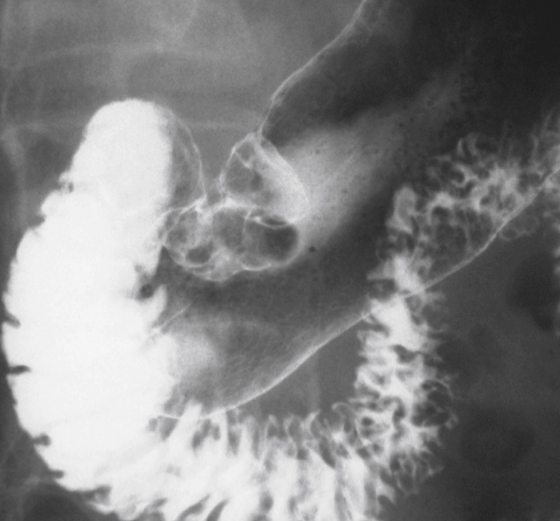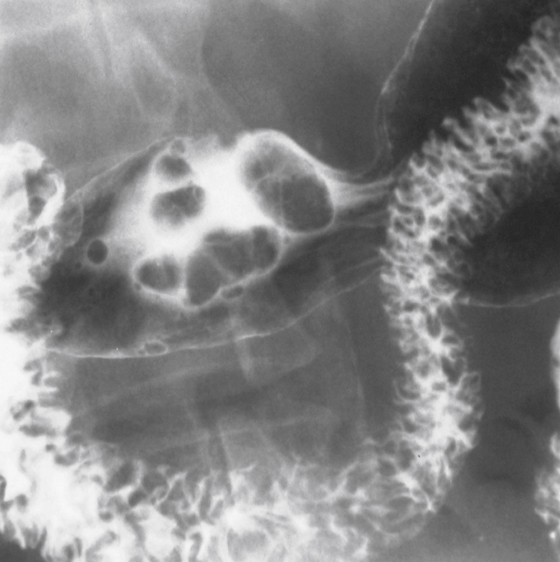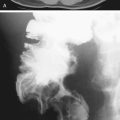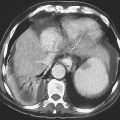CASE 90


History: A 74-year-old man presents after noticeable darkening of his feces.
1. Which of the following should be included in the differential diagnosis of the imaging finding shown in the figures? (Choose all that apply.)
2. What is the most common type of multiple gastric polyps?
3. With which polyposis syndrome is gastric adenomas associated?
4. A patient with multiple gastric polyps also manifests circumoral papillomatosis and skeletal malformations. What polyposis syndrome does the patient have?
ANSWERS
CASE 90
Multiple Gastric Polyps
1. A, B, and C
2. B
3. B
4. A
References
Buck JL, Harned RK. Polyposis syndromes. In: Gore RM, Levine MS, eds. Textbook of Gastrointestinal Radiology. 2nd ed Philadelphia: WB Saunders; 2000:44–65. 1075-1088
Cross-Reference
Gastrointestinal Imaging: THE REQUISITES, 3rd ed, p 72.
Comment
With the increased use of biphasic upper gastrointestinal examination, it is not uncommon to encounter multiple small polyps within the gastric lumen. These growths are often found throughout the body and in the proximal stomach. For the most part these small polyps are the sequelae of previous inflammation of the stomach and histologically are hyperplastic or inflammatory polyps (see figures). On occasion, they are due to metastases, and rarely they indicate the presence of a polyposis syndrome of the gastrointestinal tract.
Almost all polyposis syndromes can cause polyps to develop in the stomach. Patients with familial polyposis (or Gardner’s syndrome) have a high incidence of gastric polyps. Unlike their adenomatous counterparts in the colon, gastric polyps can be either adenomatous or hyperplastic. Patients with Peutz-Jeghers syndrome develop hamartomatous lesions in the stomach with no malignant potential. Juvenile polyps also are hamartomas and can occur sporadically or as part of a diffuse juvenile polyposis syndrome.
Cronkhite-Canada syndrome is a nonfamilial polyposis syndrome. It is associated with a group of skin abnormalities, including alopecia, onychodystrophy, and hyperpigmentation. Clinically these patients also have weight loss and depletion of protein and electrolytes. It is this last group of symptoms that may be life threatening. The condition usually occurs in middle-aged patients and sometimes in the elderly. Patients with Peutz-Jeghers syndrome develop hamartomatous lesions in the stomach with no malignant potential. Juvenile polyps also are hamartomas and can occur sporadically or as part of a diffuse juvenile polyposis syndrome. The polyps are inflammatory or hamartomatous and have no malignant potential. Typically the growths are quite small. Cowden’s disease is a rare cause of hamartomatous polyps in the stomach; this disorder is hereditary and results in formation of diffuse hamartomatous and ectodermal abnormalities throughout the body.
Occasionally one encounters what appear to be multiple small beadlike polyps lined up on folds in the body and antrum of the stomach. Erosions occurring in the stomach evoke an edematous response around the erosions that are sometimes mistaken for multiple small polyps. Careful barium coating of the stomach often shows the erosion (a tiny barium collection) on a raised edematous mound.







